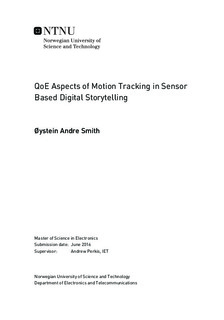QoE Aspects of Motion Tracking in Sensor Based Digital Storytelling
Master thesis
Permanent lenke
http://hdl.handle.net/11250/2415590Utgivelsesdato
2016Metadata
Vis full innførselSamlinger
Sammendrag
Storytelling is, and always will be, an important part of cultures all aroundthe world. It is used for education, to entertain and to preserve history. Sen-sor based digital storytelling is a new concept within Interactive and ImmersiveNarratives(i 2 n) where sensors are used to offer interactivity, multi-sensory stim-uli and non-linear storylines. These features are important in order to make theParticipants immersed in the story, meaning that they will move to another men-tal state and perceive the story as they were a part of it. The work related to thisreport is researching interactivity in sensor based digital storytelling with focuson Quality of Experience(QoE). It aims to investigate how the QoE is influencedby different motion tracking systems and the level of accuracy needed in the in-teraction. The research is valuable in order to enhance the QoE in sensor baseddigital storytelling by getting a better understanding of the interactivity aspect.
This report describes the design and the implementation of a system for sensorbased digital storytelling. The system consists of two motion tracking systems,Leap Motion and OptiTrack, a Head Mounted Display(HMD), Oculus Rift DK2,and a Storyteller Tool, the game engine Unity. In Unity three stories using thissystem were created in order to use them in an experiment investigating theabove questions. The experiment was conducted after a methodology describedin a research protocol developed as a part of this project.
OptiTrack was chosen as one of the motion tracking systems because it wasof great interest to see if it was possible to use it for hand -and finger tracking insensor based digital storytelling. The implementation showed that it was possi-ble to use OptiTrack for finger tracking, but that it was a bit difficult with theavailable software release TrackingTools.
In total 50 Participants conducted the experiment. Both objective and subjectivemeasures were gathered and used in the analysis. The objective measure usedwas the time used to finishing the stories, while a questionnaire was used to getthe subjective data. It was also saved paths for how the Participants moved theirhands or head, but after conducting an expert test the data was found to difficultto analyze. The results stated that it could not be found any significant differencebetween the QoE of the two systems, but the tendency was that the Participantsexperienced OptiTrack as slightly better. The experiment also showed that theParticipants had a significantly higher QoE when the level of accuracy neededin the interaction was low, compared to when the level of accuracy needed washigh.
